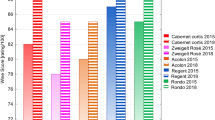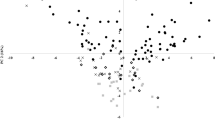Abstract
Brandy de Jerez is differentiated from other brandies by its distinctive and unique organoleptic characteristics that are derived basically from its traditional system of production, from the characteristics of the wooden cask in which it is aged and, naturally, also from climatic characteristics of the geographic area where it is exclusively made. With a view to ensuring its quality, in the present study, an ageing solera of Brandy de Jerez has been characterised analytically. The samples have been obtained in a winery of the production zone over a 2-year period, and the following analytical parameters have been monitored: colour, index of total polyphenols, short-chain organic acids and the analysis of particular polyphenolic compounds. This paper has studied the evolution of these parameters and their possible correlation with the age of the samples. A statistical model has been devised that allows the samples to be classified correctly in function of their mean age.






Similar content being viewed by others
References
Savchuk SA, Kolesov GM (2005) Markers of the nature of ethyl alcohol: chromatographic techniques for their detection. J Anal Chem 60:1239–1250
Cadahía E, De Simón BF, Vallejo R, Sanz M, Broto M (2007) Volatile compound evolution in Spanish oak wood (Quercus petraea and Quercus pyrenaica) during natural seasoning. Am J Enol Vitic 58:163–172
García Moreno M, García Barroso C (2002) Comparison of the evolution of low molecular weight phenolic compounds in typical Sherry wines: Fino, Amontillado, and Oloroso. J Agric Food Chem 50:7556–7563
Hernández T, Estrella I, Dueñas M, De Simón BF, Cadahía E (2007) Influence of wood origin in the polyphenolic composition of a Spanish red wine aging in bottle, after storage in barrels of Spanish, French and American oak wood. Eur Food Res Technol 224:695–705
Schwarz M, Rodríguez M, Martínez C, Bosquet V, Guillén D, Barroso CG (2009) Antioxidant activity of Brandy de Jerez and other aged distillates, and correlation with their polyphenolic content. Food Chem 116:29–33
Canas S, Casanova V, Pedro Belchior A (2008) Antioxidant activity and phenolic content of Portuguese wine aged brandies. J Food Comp Anal 21:626–633
García-Puente Rivas E, Alcalde-Eon C, Santos-Buelga C, Rivas-Gonzalo JC, Escribano-Bailón MT (2006) Behaviour and characterisation of the colour during red wine making and maturation. Anal Chim Acta 563:215–222
Del Álamo M, Nevares I, Gallego L, Martin C, Merino S (2008) Aging markers from bottled red wine aged with chips, staves and barrels. Anal Chim Acta 621:86–99
Guillén DA, Palma M, Natera R, Romero R, Barroso CG (2005) Determination of the age of Sherry wines by regression techniques using routine parameters and phenolic and volatile compounds. J Agric Food Chem 53:2412–2417
Lamikanra O (1997) Changes in organic acid composition during fermentation and aging of noble Muscadine wine. J Agric Food Chem 45:935–937
Schwarz M, Rodríguez MC, Guillén DA, Barroso CG (2009) Development and validation of UPLC for the determination of phenolic compounds and furanic derivatives in Brandy de Jerez. J Sep Sci 32:1782–1790
Guillén DA, Barroso CG, Zorro L, Carrascal V, Pérez-Bustamante JA (1998) Organic acids analysis in ‘Brandy de Jerez’ by ion-exclusion chromatography, ‘post-column’ buffering and conductimetric detection. Analusis 26:186–189
Singleton VL, Rossi JA (1965) Colorimetry of total phenolics with phosphomolybdic-phosphotungstic acid reagents. Am J Enol Vitic 16:144–158
Jeuring HJ, Kuppers FJ (1980) High performance liquid chromatography of furfural and hydroxymethylfurfural in spirits and honey. J Assoc Off Anal Chem 63:1215–1218
Rodríguez Madrera R, Blanco Gomis D, Mangas Alonso JJ (2003) Influence of distillation system, oak wood type, and aging time on composition of cider brandy in phenolic and furanic compounds. J Agric Food Chem 51:7969–7973
Caldeira I, Clímaco MC, Bruno De Sousa R, Belchior AP (2006) Volatile composition of oak and chestnut woods used in brandy ageing: Modification induced by heat treatment. J Food Eng 76:202–211
Rodríguez-Bencomo JJ, Ortega-Heras M, Pérez-Magariño S, González-Huerta C, González-San José ML (2008) Importance of chip selection and elaboration process on the aromatic composition of finished wines. J Agric Food Chem 56:5102–5111
Quesada Granados J, Villalón Mir M, López Serrana H, López Martinez MC (1996) The influence of added caramel on furanic aldehyde content of matured brandies. Food Chem 56:415–419
Karadeniz F, Durst RW, Wrolstad RE (2000) Polyphenolic composition of raisins. J Agric Food Chem 48:5343–5350
Rodríguez Dodero MC (2005) Analytical study of phenolic composition of sherry brandy and its relation to the elaboration process, ageing, characterization and quality. Ed. Bell and Howell, Cádiz
Moreno MVG, Jurado JC, Barroso CG (2001) Method devised for determining low molecular weight organic acids in vinic samples by capillary electrophoresis: validation of the method with real samples. Eur Food Res Technol 213:381–385
Quesada Granados J, Villalón Mir M, López García-Serrana H, Hopez Martínez MC (1996) Influence of aging factors on the furanic aldehyde contents of matured brandies: Aging markers. J Agric Food Chem 44:1378–1381
Acknowledgments
The authors are most grateful to Bodega Sánchez-Romate for providing the samples. This study has been financed by Project P05-AGR-00767 and the “Plan Nacional de Tecnologia de Alimentos” (Project: RTA2006-00036-C02-02).
Author information
Authors and Affiliations
Corresponding author
Rights and permissions
About this article
Cite this article
Schwarz, M., Rodríguez, M.C., Guillén, D.A. et al. Analytical characterisation of a Brandy de Jerez during its ageing. Eur Food Res Technol 232, 813–819 (2011). https://doi.org/10.1007/s00217-011-1448-2
Received:
Revised:
Accepted:
Published:
Issue Date:
DOI: https://doi.org/10.1007/s00217-011-1448-2




